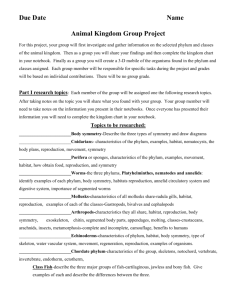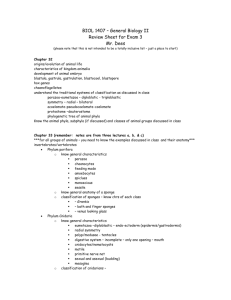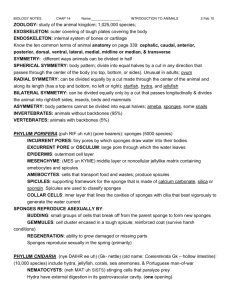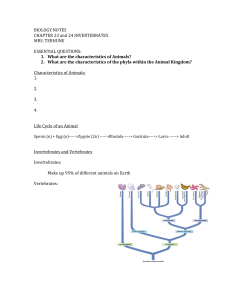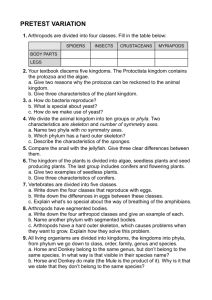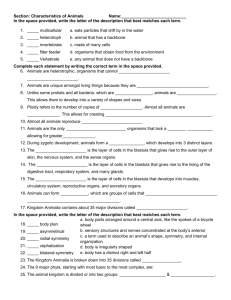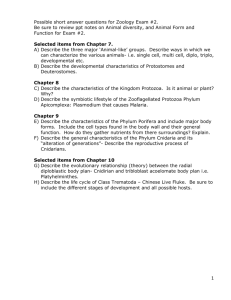Animal Classification
advertisement
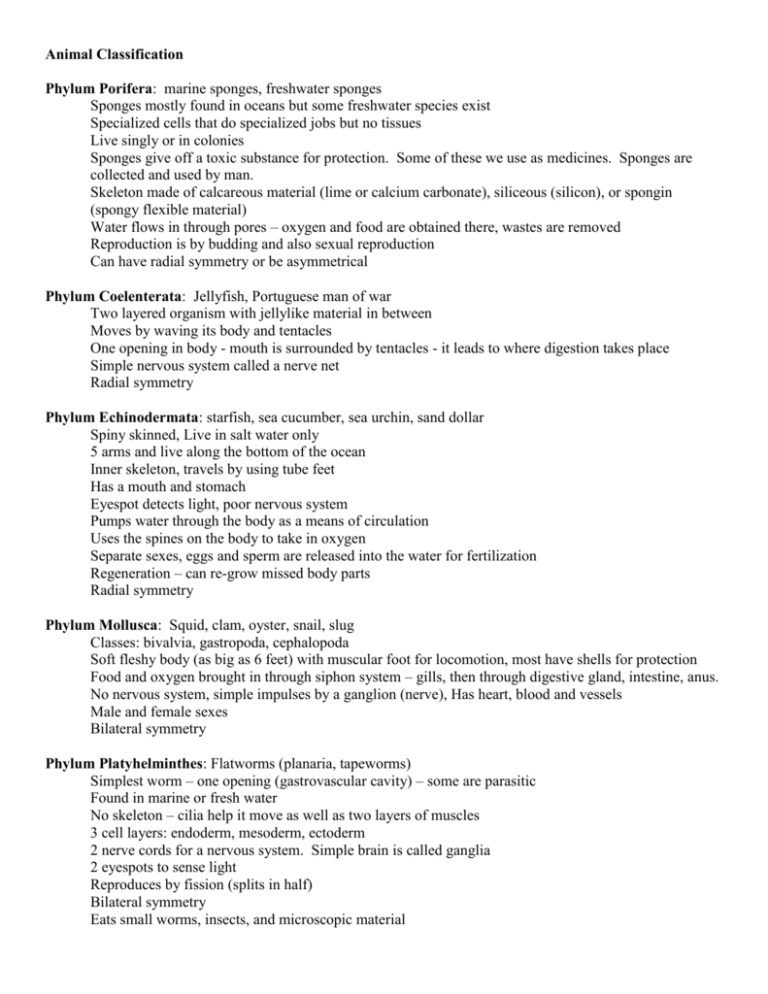
Animal Classification Phylum Porifera: marine sponges, freshwater sponges Sponges mostly found in oceans but some freshwater species exist Specialized cells that do specialized jobs but no tissues Live singly or in colonies Sponges give off a toxic substance for protection. Some of these we use as medicines. Sponges are collected and used by man. Skeleton made of calcareous material (lime or calcium carbonate), siliceous (silicon), or spongin (spongy flexible material) Water flows in through pores – oxygen and food are obtained there, wastes are removed Reproduction is by budding and also sexual reproduction Can have radial symmetry or be asymmetrical Phylum Coelenterata: Jellyfish, Portuguese man of war Two layered organism with jellylike material in between Moves by waving its body and tentacles One opening in body - mouth is surrounded by tentacles - it leads to where digestion takes place Simple nervous system called a nerve net Radial symmetry Phylum Echinodermata: starfish, sea cucumber, sea urchin, sand dollar Spiny skinned, Live in salt water only 5 arms and live along the bottom of the ocean Inner skeleton, travels by using tube feet Has a mouth and stomach Eyespot detects light, poor nervous system Pumps water through the body as a means of circulation Uses the spines on the body to take in oxygen Separate sexes, eggs and sperm are released into the water for fertilization Regeneration – can re-grow missed body parts Radial symmetry Phylum Mollusca: Squid, clam, oyster, snail, slug Classes: bivalvia, gastropoda, cephalopoda Soft fleshy body (as big as 6 feet) with muscular foot for locomotion, most have shells for protection Food and oxygen brought in through siphon system – gills, then through digestive gland, intestine, anus. No nervous system, simple impulses by a ganglion (nerve), Has heart, blood and vessels Male and female sexes Bilateral symmetry Phylum Platyhelminthes: Flatworms (planaria, tapeworms) Simplest worm – one opening (gastrovascular cavity) – some are parasitic Found in marine or fresh water No skeleton – cilia help it move as well as two layers of muscles 3 cell layers: endoderm, mesoderm, ectoderm 2 nerve cords for a nervous system. Simple brain is called ganglia 2 eyespots to sense light Reproduces by fission (splits in half) Bilateral symmetry Eats small worms, insects, and microscopic material Phylum Nematoda: hookworm, pinworm, trichinella Thin round bodies, two openings – “tube within a tube” Live in fresh water, marine water, or the soil A majority of them are parasites No skeleton, digestive system runs the length of their bodies Two nerve cords, no vessels, can be up to 4 ft. in length Sexual reproduction Bilateral symmetry Phylum Annelida: earthworms, leeches Most highly developed worms Body is divided into segments or parts – no skeleton Bristles called setae to help in movement, has two sets of muscles Two openings, more advanced digestion and includes a crop (storage) and a gizzard (grinds food) Nervous system with simple brain and a nerve cord Blood and blood vessels with 5 hearts Exchanges gases through the skin (must stay moist to do so) Are hermaphroditic (has both sexes in the same body) but sperm is exchanged to another earthworm Bilateral symmetry Phylum Arthropoda: Most abundant of all the animal phyla Classes of arthropods: Chilopoda, Diploda, Merostomata, Crustacea, Arachnida, Insecta Has jointed limbs (appendages) that are paired Exoskeleton made of chitin, Segmented body having two or three sections (head, thorax, abdomen or cephalothorax and abdomen) 2 openings, digestion runs through organism Open circulatory system More advanced brain and nerves Striated muscles Gills, trachea, or spiracles for respiration (depends upon class) Separate sexes mostly, sexual reproduction Bilateral symmetry Phylum Chordata: Classes of chordates: Agnatha, Chondricthyes, Osteicthyes, Amphibia, Reptilia, Aves, Mammalia Have backbone and an inner skeleton Generally have 4 appendages that are paired (legs, arms, wings, or fins) Mouth has a tongue. Some have teeth. Have a digestive system Most developed of brain and nervous system, 2 eyes and some sense of hearing Can be warm or cold-blooded, exchanges gases through use of lungs or gills Sexual reproduction Complex skin that is covered by feathers, scales, or hair Bilateral symmetry

